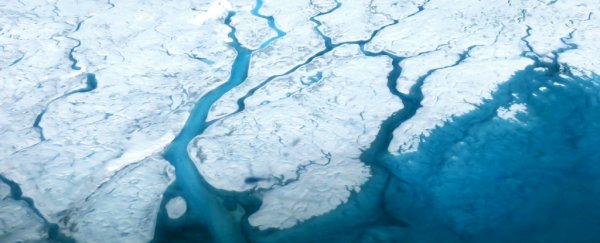There is more to the Greenland ice sheet than meets the eye. Hiding in the depths of West Greenland's Store Glacier, scientists have found a surprising amount of liquid water.
The new analysis is the very first to demonstrate liquid water trapped in solid, glacial ice. And if the feature extends to other glaciers, it could transform the way we measure melting ice and sea-level rise.
"All of our predictions of sea-level rise are missing this meltwater component," says co-author Dustin Schroeder, a researcher in the behaviour of Earth's water and ice at Stanford University.
"I think we're only just realising how important it is to understand at a fundamental physical scale what glacier meltwater does on its way from the surface to the bed."
Little is currently known about what happens below the surface of the Greenland ice sheet. Rising to 3,200 metres (10,500 feet) at its highest point, the frozen colossus leaves plenty of room for mystery.
Much of what we do know is limited to the surface. When ice on top of the Greenland ice sheet melts, the water gathers in glacial lakes before draining through a complex "plumbing" system.
Once inside these icy pipes, the course of meltwater is more difficult to predict. It's commonly thought that streams of liquid water trace a weaving path of sheer crevasses and plunge pools until they reach the bottom.
Here, nestled between the ice sheet and the ground, the liquid water creates a slippery base that allows the glacier to flow into the ocean more easily, and melt faster.
Now, however, there may be another component to glacier flow that current climate models have not yet taken into account.
Instead of travelling directly to the bottom, the new study suggests the delivery of some meltwater is delayed, potentially buying the rapidly melting glaciers more time.
Analysing 2014 data from a radio-echo sounder, which works sort of like an ultrasound for ice, the researchers were able to map variations in the Store Glacier's ice density at high resolution.
Just like an ultrasound reveals the growth and movements of a foetus, these electronic waves provided scientists a glimpse into how the glacier melts and moves over time.
But when lead author Alexander Kendrick, who researches fluid flow and porous materials at Stanford, began plotting the radar data, he noticed an idiosyncrasy - a little blip of information that happened to occur at the same time as a period of glacial melting.
That finding turned out to be a hidden aquifer, an example of ice that has been filled with meltwater from the summertime.
And this wasn't just a little bit of water. Kendrick and his team estimate 1.3 to 2.6 metres (4 to 9 feet) of surface meltwater is stored in porous ice between 4.6 metres and 45 metres (15 to 150 feet) of depth.
This suggests that most of the meltwater from that summer did not make its way to the bottom of the glacier.
Instead, it became trapped in ice cracks and crevices during its journey. And only with the advent of winter was the water released back into the plumbing or refrozen once again.
"The water system of Greenland is critical for understanding what's happening on the planet," says Schroeder.
"This component Alex has discovered shows that there is a piece of this glacier in particular - and maybe the entire Greenland hydrologic system in general - that we just were not modelling or thinking about in this way."
Thanks to global warming, for over a decade the Greenland ice sheet has been losing an estimated 244 billion tonnes of ice each year. And there's no sign of it slowing down.
A study published earlier this year revealed that a chain reaction of water drainage in the Greenland ice sheet is capable of temporarily speeding up ice flow by as much as 400 percent.
If the sheet melts completely, it could raise the height of the ocean surface by up to 7 metres (23 feet). As such, understanding the flow of the Greenland ice sheet is a crucial consideration for climate models.
But if the water storage that Kendrick and his team have identified is a pervasive and overlooked feature of glaciers, predictions for water drainage will need to be reevaluated.
Without acknowledging the existence of internal aquifers, climate models will fail to capture the entire role of surface melt in the stability of the glacier and its contribution to sea-levels.
"Things like this don't always come along, but when they do, that is the real 'joy of the discovery' component of Earth science," says Schroeder.
"This paper not only highlights this component's existence, but gives you a way to observe it in time."
This study has been published in Geophysical Research Letters.
